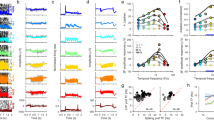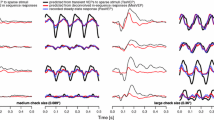Abstract
Evidence is controversial in respect to the optimal conditions in which visual evoked potentials provide an objective measure of binocular visual function, related and unrelated to stereopsis, and there is little emphasis on the type of stimulus that produces facilitation in binocular recording. We investigated the effects of stimulus type (flicker or pattern), contrast, and temporal modulation on facilitation, which was defined as a binocular response greater than sum of monocular responses. Monocular and binocular responses to sinusoidally modulated flicker and grating patterns were recorded in children and Fourier analyzed. The relationship of the fundamental Fourier component for flicker and the second harmonic component for pattern were each examined as function of temporal modulation at two levels of contrast for monocular and binocular visual evoked potentials. Binocular facilitation was found across all conditions for flicker. Data suggest that processing of pattern and flicker has different sites of origin within the visual system. Facilitation in binocular visual evoked potentials also indicates that they are not a result of simple summation of monocular responses, since there appears a nonlinear component to such interaction.
Similar content being viewed by others
References
Ross JF, Clarke DD, Bron AJ. Effect of age on contrast sensitivity function: uniocular and binocular findings. Br J Ophthalmol 1985; 69: 51–6.
Blake R, Sloane M, Fox R. Further developments in binocular summation. Percept Psychophysics 1981; 30: 266–276.
Arditi A. Binocular vision. In Boff, Kaufman, Thomas eds. Handbook of perception and human performance. New York: Wiley, 1986.
Jones RK, Lee DN. Why two eyes are better than one: The two views of binocular vision. J Exp Psychol: Human Percept 1981; 7: 30–40.
Campbell FW, Green DG. Monocular versus binocular visual acuity. Nature 1965; 208: 191–2.
Green DM, Swets JA. Signal detection theory and psychophyics. New York: Wiley, 1966.
Srebro R. The visually evoked response. Arch Ophthalmol 1978; 96: 839–44.
Apkarian PA, Nakayama K, Tyler CW. Binocularity in the human visual evoked potential: Facilitation, summation and suppression. EEG Clin Neurophysiol 1981; 51: 32–48.
Amigo G, Fiorentini A, Pirchio M, Spinelli D. Binocular vision tested with visual evoked potentials in children and infants. Invest Ophthalmol Vis Sci 1978; 17: 910–15.
Nuzzi G, Franchi A. Binocular interaction in visual evoked responses: Summation, facilitation and inhibition in a clinical study of binocular vision. Ophthalmol Res 1983; 15: 261–4.
Katsumi O, Oguchi Y, Kawara T, Peli E. Effects of stimulus contrast on binocular VER. Jpn J Ophthalmol 1984; 28: 401–8.
Katsumi O, Tanino T, Hirose T. Objective evaluation of binocular function using the pattern reversal visual evoked response. II. Effect of mean luminosity. Acta Ophthalmol 1986; 64: 199–205.
Katsumi O, Tanino T, Hirose T. Objective evaluation of binocular function with pattern reversal VER. III. Effect of stimulus size and localization. Acta Ophthalmol 1986; 64: 691–7.
Tari E, Janaky M, Benedek G. Age dependence of visual evoked potential parameters in children. Doc Ophthalmol Proc Series 1984; 40: 279–86.
Leguire LE, Fellows RR, Rogers GL, Bremner DL. Binocular summation and facilitation of latency in flash and pattern VERs in 6 to 30 month old children. Binoc Vision 1987; 2: 15–23.
Shea SL, Aslin RM, McCulloch D. Binocular VEP summation in infants and adults with abnormal binocular histories. Invest Ophthalmol Vis Sci 1987; 28: 356–65.
Hubel D, Wiesel T. Receptive fields, binocular interaction and functional architecture in cat's visual cortex. J Physiol (Lond) 1962; 160: 106–154.
Maske R, Yamame D, Bishop PO. Binocular simple cells for local stereopsis: comparison of receptive field organization for the two eyes. Vis Res 1984; 24: 1921–9.
Wolfe JM, Held R. Cyclopean stimulation can influence sensations of self-motion in normal and stereoblind subjects. Percept Psychophysics 1980; 28: 139–42.
Wolfe JM, Held R, Bauer JA Jr. A binocular contribution to the production of optokinetic nystagmus in normal and stereoblind subjects. Vis Res 1981; 21: 587–90.
Author information
Authors and Affiliations
Rights and permissions
About this article
Cite this article
Paley, R.T., Sutija, V.G. & Solan, H.A. Nonlinearities in binocular visual evoked potentials in children. Doc Ophthalmol 72, 9–19 (1989). https://doi.org/10.1007/BF00155209
Issue Date:
DOI: https://doi.org/10.1007/BF00155209




